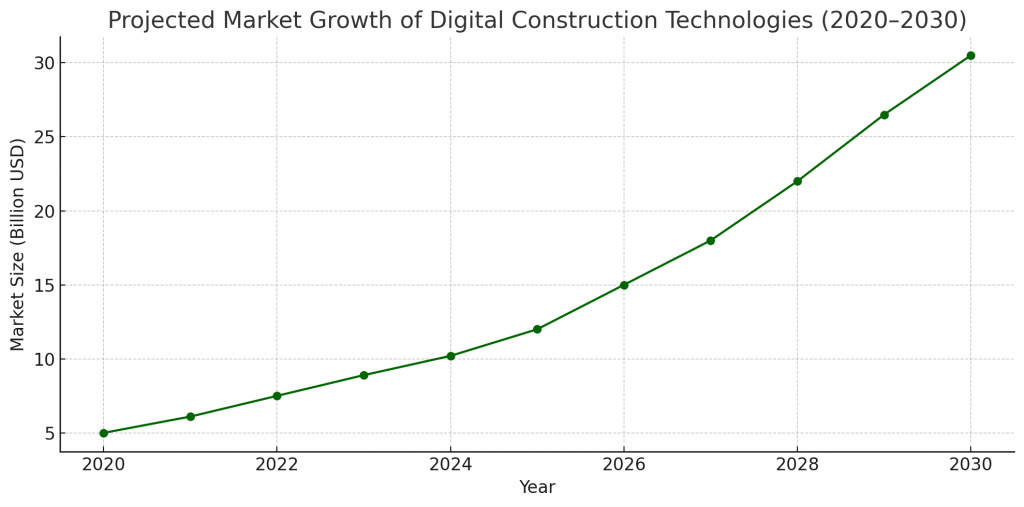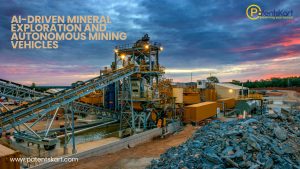What Are Digital Construction Technologies and Why Do They Matter?
The construction industry is no longer just about bricks and mortar. As the world moves towards smarter cities and sustainable infrastructure, digital construction technologies have emerged as the foundation for modern building practices. These technologies integrate intelligent design, automation, real-time data, and cloud-based systems to drive efficiency, cut costs, and promote environmental responsibility.
In a space historically resistant to change, digital transformation is now mandatory. Whether it’s artificial intelligence (AI), building information modeling (BIM), or robotics—construction sites are evolving. Companies like Autodesk, Siemens, and Trimble are leading the charge with BIM-integrated workflows, IoT-powered monitoring, and real-time digital twins. These advancements, supported by a growing body of patents and international standards, are the future of the industry.
How Does Smart Design & Planning Empower Modern Construction?
The planning phase is critical, and with smart digital tools, it’s being revolutionized. Building Information Modeling (BIM) is at the heart of this transformation. It provides a data-rich 3D model that integrates architectural, structural, and systems designs for improved collaboration and clash detection. Supported by standards such as ISO 19650 and IFC formats, BIM ensures interoperability across platforms.
AI-based generative design tools further enhance efficiency by exploring thousands of layout options, helping architects and engineers optimize space, materials, and energy usage. Companies like Graphisoft and Trimble are investing in tools that integrate BIM with energy simulation, environmental assessments, and even AR/VR walkthroughs. These innovations reflect the growing importance of digital construction technologies in early-stage decision-making.
In What Ways Are Robotics and Automation Revolutionizing Construction Sites?
Automation and robotics are redefining physical labor on construction sites. 3D concrete printing is being used by companies like ICON and Apis Cor to create entire structures with speed and precision, reducing both labor and material costs. Meanwhile, Boston Dynamics’ Spot robot is performing autonomous site inspections, showcasing the future of AI-integrated mobility in construction.
Drones are now routine tools for surveying, site progress documentation, and safety inspection. Automated bricklaying and robotic arms—once seen as futuristic—are operational in pilot projects around the world. The result? Reduced project timelines, higher safety standards, and greater construction precision. These advances clearly place robotics and automation at the core of next-generation digital construction technologies.
Why Is Construction Management Software Critical to Digital Workflows?
Behind every successful build is a streamlined management system. Digital construction technologies include cloud-based project management tools like Procore and Buildertrend, which offer real-time dashboards for tracking progress, budget, and schedules.
These systems are increasingly enhanced with AI algorithms that forecast delays, flag risks, and optimize resource allocation. Companies like Hexagon and Bentley Systems are also integrating digital twin technology with field data to simulate project behavior and minimize costly overruns. Seamless communication across teams, centralized documentation, and predictive analytics are making traditional construction workflows obsolete.
How Is Smart On-Site Monitoring Improving Safety and Compliance?
IoT-based safety systems and wearables are revolutionizing how on-site safety is managed. From noise and air quality sensors to geolocation trackers embedded in helmets and vests, job sites are becoming intelligent environments that respond to real-time conditions.
Startups like Smartvid.io and Triax Technologies are leading the way in smart monitoring, offering platforms that use AI to analyze camera footage and detect unsafe behaviors. These innovations are not just improving safety—they are ensuring regulatory compliance with green construction codes and labor standards. Integrated into broader systems, they contribute to a safer and smarter digital construction technologies ecosystem.
How Do Digital Tools Enhance Sustainable and Efficient Building?
Sustainability is a central driver of innovation. Tools like lifecycle assessment (LCA) and energy simulation software help stakeholders evaluate the environmental impact of materials and systems before construction even begins.
Firms like Arup and Schneider Electric are integrating digital platforms with environmental product declarations (EPDs), guided by standards like ISO 22057. AI and machine learning algorithms are now being used to suggest low-carbon material choices, optimize construction sequencing, and even calculate embodied emissions. By embedding sustainability metrics directly into the design process, digital construction technologies are creating measurable environmental and financial value.
How Is Facility Management Evolving with Digital Construction?
The impact of digital technologies extends beyond construction into the lifecycle of the building. Facility management is becoming predictive thanks to digital twins and IoT integration. These twins simulate how buildings behave under different conditions, providing actionable insights for maintenance and energy use.
Tools based on COBie and bSDD standards enable seamless handovers from construction to operations. Companies like Siemens and Honeywell offer smart building platforms that connect lighting, HVAC, and occupancy sensors into one cohesive dashboard. Predictive maintenance, lower operational costs, and optimized space utilization all result from the strategic use of digital construction technologies in FM.
What Innovative Technologies Are Shaping the Future of Construction?
The frontier of innovation is constantly expanding. Blockchain is being explored for smart contracts and transparent material tracking. AI is improving everything from scheduling to compliance, while AR and VR are being used for immersive training, remote inspections, and virtual client presentations.
Startups like Disperse and OpenSpace are applying machine vision to automate project tracking and documentation. These emerging tools not only enhance project accuracy but also unlock new levels of stakeholder engagement. They represent the bold, experimental edge of digital construction technologies, pushing the industry into uncharted territory.
Which Companies Are Leading in Digital Construction Technologies?
Several key players dominate this evolving landscape:
| Domain | Leading Companies |
| BIM & Design | Autodesk, Trimble, Graphisoft |
| Automation & Robotics | ICON, Boston Dynamics, Apis Cor |
| Smart Monitoring | Smartvid.io, Triax Technologies |
| Facility Management | Siemens, Honeywell, Johnson Controls |
| Project Management | Procore, Bentley Systems, Hexagon |

These companies are driving innovation through patents, partnerships, and global deployments. Their work forms the infrastructure for the adoption of advanced digital construction technologies worldwide.
Are There Standards Guiding the Adoption of Digital Construction?
Yes—global standards are critical to ensuring consistency and collaboration:
| Standard | Purpose |
| ISO 16739 (IFC) | BIM data formats |
| ISO 19650 | BIM lifecycle management |
| COBie | Facility data exchange |
| ISO 22057 | Sustainability reporting |
| bSDD | Object property definitions |
These standards ensure that software platforms and hardware tools can communicate effectively, enabling the secure and scalable implementation of digital construction technologies.
What Is the Market Outlook for Digital Construction Technologies?
The market for digital construction technologies is expanding rapidly, with projections exceeding $30 billion globally by 2030. This growth is fueled by smart city initiatives, increasing demand for green buildings, and persistent labor shortages.

Patent data shows significant activity across jurisdictions like the U.S., China, Germany, and Japan. Cross-sector collaborations between construction firms and tech providers are becoming more common. As TRLs advance and regulatory support increases, the barriers to adoption continue to fall—making digital construction the standard, not the exception.
FAQs About Digital Construction Technologies
-
What are digital construction technologies?
They include BIM, robotics, AI, IoT, and management platforms used to digitize and improve construction workflows.
-
How does AI help in construction?
AI optimizes scheduling, detects safety risks, and predicts maintenance needs.
-
What is a digital twin in construction?
It’s a live virtual model of a building used for monitoring and simulation.
-
Are digital tools viable for small firms?
Yes, with SaaS models and modular tools, small to mid-size firms can adopt them.
-
What’s the role of standards in digital construction?
Standards like ISO and COBie ensure interoperability and data integrity.
How Can PatentsKart Help You Succeed in Digital Construction?
If you’re navigating this fast-evolving space, PatentsKart helps by:
- Analyzing emerging tech landscapes
- Tracking patents and standards
- Identifying innovation and IP opportunities
- Mapping competitor activity
Visit www.patentskart.com or or contact us at info@patentskart.com to stay ahead.
Conclusion: Why Should You Embrace Digital Construction Technologies Today?
The construction industry is standing at a pivotal crossroads. Traditional methods are being replaced by smarter, faster, and more data-driven processes. As we build the cities of tomorrow, the integration of digital construction technologies isn’t just an upgrade—it’s a necessity. From planning and automation to sustainable development and lifecycle management, these technologies are solving age-old problems with next-gen innovation.
Forward-looking companies are already leveraging digital platforms to stay ahead of the curve. The benefits are clear: reduced waste, improved safety, real-time insights, and long-term cost savings. By embracing this transformation now, you position your business to thrive in an increasingly competitive and sustainable world.
Let your next project be a digital one—and lead the change.
Visit patentskart.com to explore how we can support your digital construction journey, or reach out at info@patentskart.com.







